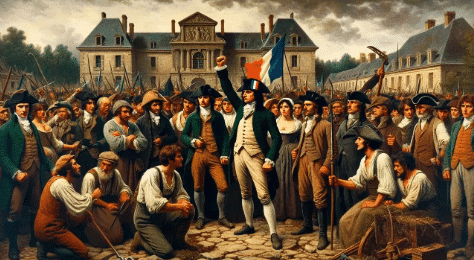NCERT Solutions for Class 11 History - The Three Orders
Q1. Describe two features of early feudal society in France.
Ans: Two features of early feudal society in France are:
- Lord's Authority: The lord held a special status, and his orders were absolute. No one could challenge his authority.
- Peasant-Lord Relationship: Society was built on the relationship between lords and peasants. Peasants provided labour in exchange for protection and land.
- Social Hierarchy: Early society was divided into three main groups: priests, nobles, and peasants. The nobility played a dominant role in this structure.

Q2. How did long-term changes in population levels affect economy and society in Europe?
Ans: Long-term changes in population levels significantly impacted the economy and society in Europe:
- Towns emerged as centres of trade and commerce, leading to a more advanced and civilised society.
- Increased agricultural production reached its peak, resulting in better quality goods and a rise in life expectancy.
- As agriculture improved, towns began to grow again, providing peasants with places to sell surplus grain and buy necessary tools.
- The shift towards a cash economy changed the nature of economic transactions, with lords preferring rent in cash rather than services.
Q3. Why did knights become a distinct group, and when did they decline?
Ans: During the ninth century, Europe experienced frequent local wars. This led to a shortage of trained cavalry, creating a demand for skilled horsemen. As a result:
- Knights emerged as a distinct group to meet the needs of localised conflicts.
- They were linked to lords, who provided them with land, known as a fief, in exchange for military service.
- The decline of the knights began in the 15th century as feudal power weakened.
Knights played a crucial role in the feudal system, but changing economic conditions and the rise of new military strategies contributed to their decline.
Q4. What was the function of medieval monasteries?
Ans: The function of medieval monasteries included:
- Encouraging people to donate to religious causes.
- Inspiring service to the sick and needy.
- Promoting the development of art and architecture.
- Encouraging a simple life among the community.
Q5. Imagine and describe a day in the life of a craftsman in a medieval French town.
Ans: A day in the life of a craftsman in a medieval French town was structured and busy. Here are some key aspects:
- Guild Supervision: Craftsmen worked under the guidance of trading guilds, which ensured quality and standards.
- Skilled Work: They were skilled individuals, often specialising in a particular craft.
- Community Role: Craftsmen played a vital role in the local economy, providing goods and services.
- Daily Routine: Their day typically involved crafting, trading, and attending guild meetings.
Q6. Compare the conditions of life for a French serf and a Roman slave.
Ans: French serf:
- Serfs worked on land owned by the lord.
- Most of the produce was given to the lord, leaving serfs with little.
- They could not leave the estate without the lord's permission.
- Serfs were not allowed to marry without the lord's consent.
- They performed unpaid labour services, such as gathering firewood and repairing roads.
- Serfs received no wages for their work.
Roman slave:
- Slaves were considered property and could be bought or sold.
- They had no rights or identity of their own.
- Slaves were forced to work long hours without compensation.
- They were often compelled to have children, who would also become slaves.
|
27 videos|125 docs|20 tests
|
FAQs on NCERT Solutions for Class 11 History - The Three Orders
| 1. What are the three orders mentioned in the article "The Three Orders"? |  |
| 2. How did the three orders impact medieval society? |  |
| 3. What were the key responsibilities of each order in the three orders system? |  |
| 4. How did the relationship between the three orders evolve over time? |  |
| 5. What is the significance of understanding the three orders in studying medieval history? |  |

















